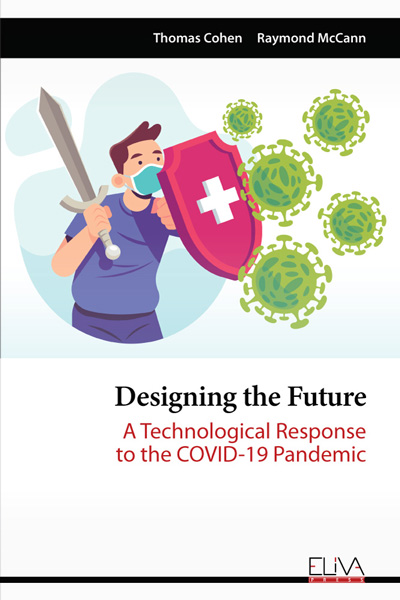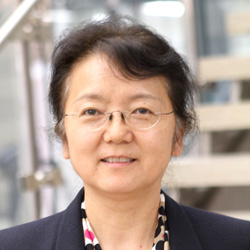New Book Spotlights Technological Response to COVID-19
Book by undergraduates examines emerging technologies that could fight against COVID-19, future pandemics
The COVID-19 pandemic isn’t yet over, but a new book written by Northwestern Engineering undergraduates spotlights how emerging technologies can help society be better prepared to handle the next viral outbreak.

“We wanted to react to the times we are in and contribute to this era in a positive way,” McCann said. “Understanding COVID-19 in a historical context and the emerging technologies all around us could dramatically change how people respond to events like this in the future.”
Learning from the past, informing the future
Written for the general public and available on Amazon, Designing the Future presents a history of past disease outbreaks, from the Black Death in 1346 through the H1N1 influenza pandemic in 2009. In studying how society responded to these events, McCann and Cohen found many now familiar preventative measures stood the test of time.
“During the 1918 Spanish Flu, people wore masks. Even going as far back as the Plague, people understood the importance of staying away from the infected and not leaving their homes,” McCann said. “Those rudimentary principles have existed for a long time and have been shown throughout history to work.”
The book’s historical overview accompanies an in-depth exploration of COVID-19, including how technology has been used to tackle the pandemic. McCann and Cohen explore three categories of technologies shown to help prevent the spread of the virus: material barriers, like surgical and cloth facemasks, gloves, and face shields; chemical disinfectants, like alcohol and heat sterilization; and microbial disinfection, using ultraviolet light. The authors reveal how each are used today, and how they could be more effective in the future.
One developing form of ultraviolet technology, for example, has been shown to pose fewer risks to humans than traditional UV-C light while still demonstrating a propensity to kill viruses and bacteria. Called Far-UVC, the technology could be used as ambient light in large public spaces reduce the ambient level of airborne viruses.
“Rather than quarantine, leveraging the ability to use ultraviolet light technology to sterilize water or the air around us could help prevent the spread of disease without upending our way of life as we did during the last year,” McCann said.
We wanted to react to the times we are in and contribute to this era in a positive way. Understanding COVID-19 in a historical context and the emerging technologies all around us could dramatically change how people respond to events like this in the future.
Ray McCann ('21)Recent graduate, mechanical engineering
Pivoting on the pandemic
During the pandemic’s early days in spring 2020, McCann felt inspired to build a device that could help limit the spread of viral disease. As a student MECH_ENG 315: Theory of Machines taught by Q. Jane Wang, professor of mechanical engineering, McCann designed the UV Roller, a handheld device with rolling brushes that picks up debris and shines ultraviolet light on a surface to disinfect it.
With social distancing guidelines in effect and Northwestern’s campus largely closed last summer, progress on developing a UV Roller prototype stalled, never moving past CAD mockups. Still motivated to make an impact, McCann pivoted his focus, connecting with Cohen and diving deep into a research exploration of COVID-19 last summer.
“Instead of focusing our attention on growing one design, we broadened our scope to give a true overview of the COVID-19 pandemic and others society have dealt with in the past,” said McCann. “Inspired by the design concepts we were developing in the Theory of Machines course, we wanted to show how society can move forward with better disease-prevention strategies using technology we already have.”
Supported by faculty
McCann and Cohen credit Wang for supporting them when they realized their research manuscript could be adapted into a book. She met with them weekly to review their progress while also helping them navigate the publishing process, from how to approach someone to write a forward to chapter formatting and organization to interacting with a publisher.

“She was the backbone,” Cohen said. “She could have easily taken more credit, but I appreciate that she made it about us. She was a great resource.”
Wang also connected the authors with Elizabeth Winslow, a junior studying mechanical engineering and radio/television/film and a member of Northwestern Engineering’s Center for Surface Engineering and Tribology. Winslow, whose undergraduate research focuses on antimicrobial materials and alloys, wrote a chapter about the differences between antimicrobial and antibacterial properties in materials, and how leveraging these properties in medical equipment, clothing, toiletries, and other household goods could help prevent the spread of disease in the future.
Sometimes the greatest innovations come from the most urgent tragedies. If there’s a positive to take from the last year, it’s that society has shown an ability to innovate so rapidly.
Thomas Cohen ('21)Recent graduate, Manufacturing and Design Engineering
Takeaways
Reflecting on their nearly year-long project, McCann and Cohen said studying COVID-19 in the context of past pandemics reinforced the importance of following “the simple things,” like hand washing, mask wearing, and keeping appropriate distance.
“These easy measures, along with a willingness to face these challenges together as a society, make a huge difference,” McCann said.
Cohen said the experience revealed a silver lining to what has otherwise been a challenging year.
“Sometimes the greatest innovations come from the most urgent tragedies,” Cohen said. “If there’s a positive to take from the last year, it’s that society has shown an ability to innovate so rapidly.”